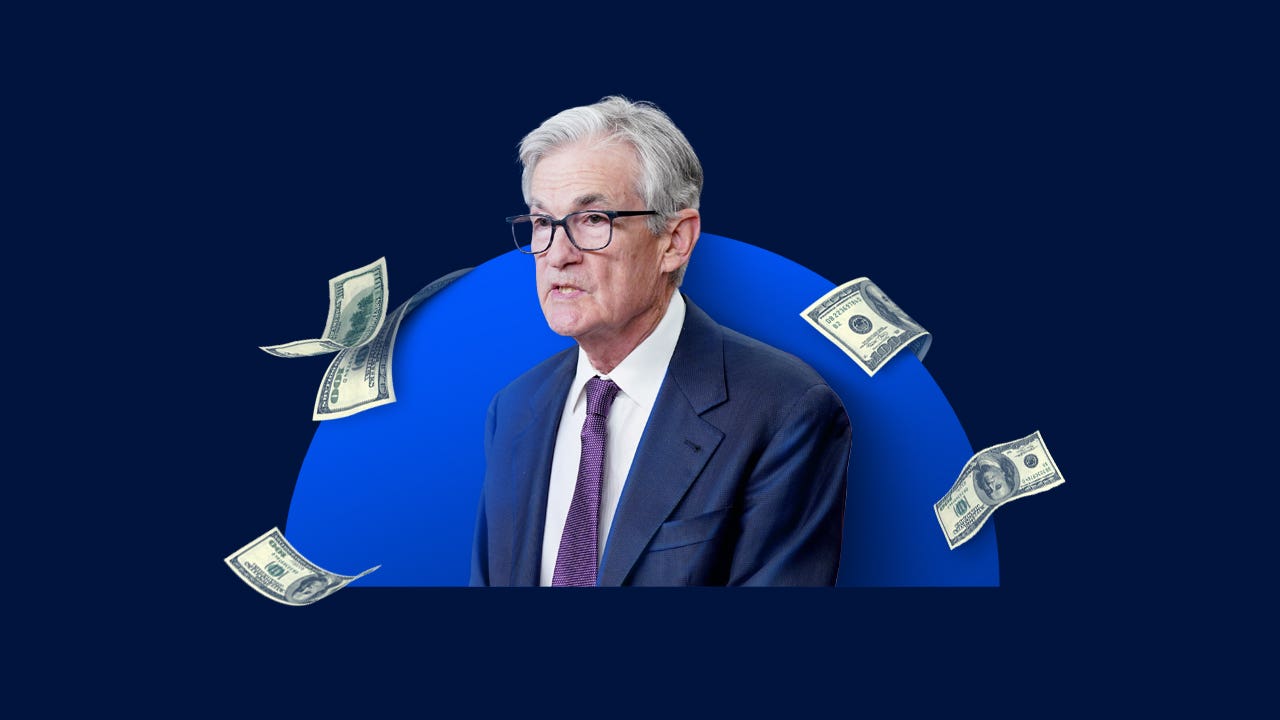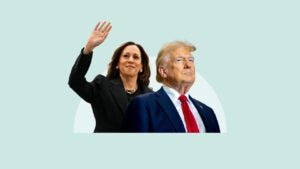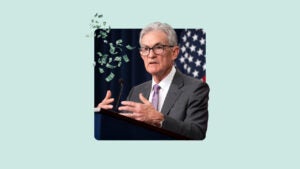Bankrate’s Q4 Economic Indicator Survey: Here’s what the nation’s top economists are predicting for the U.S. economy in 2025

Recession naysayers were proven correct yet again in 2024, as Americans’ spending powered economic growth and the job market dodged widespread fears of a major slowdown. Consumers and investors even got the interest rate cuts that they were clamoring for.
But with economists facing heightened uncertainty in the year ahead, as President Donald Trump’s incoming administration brings inevitable shifts to economic policy, a key question is emerging: Will the good times keep on rolling?
The U.S. economy has some momentum heading into the new year, economists told Bankrate in its latest quarterly Economic Indicator Survey. Joblessness has risen, but it’s still near a level most consider full employment. The economy grew even faster than originally reported in the third quarter of 2024 — and looks like it also expanded at another solid pace in the final three months of last year.
Economists put the odds of a recession by the end of 2025 at just 26 percent, a new series low, the survey found. Meanwhile, they’re projecting only a slight increase in the nation’s unemployment rate as well as a modest slowdown in hiring.
But economists noted some key downside risks, the survey found. They’re boosting their inflation forecasts, vindicating officials on the Federal Reserve who now expect to cut borrowing costs just twice this year. They’re also noting that Trump’s promises to enact universal tariffs on U.S. imports and reduce immigration could push prices higher.
Bankrate has been polling the nation’s top economists on their expectations for the job market, inflation, the Federal Reserve, economic growth and more on a quarterly basis for a decade. Read on for the latest findings.
While this might feel like history repeating in some ways, including with the return of the Trump administration, we enter 2025 with a high degree of uncertainty. Even so, participants in our survey are somewhat upbeat in their outlook.— Mark Hamrick, Bankrate senior economic analyst
Key takeaways from experts’ forecasts for the U.S. economy in 2025
The nation’s top economists expect that job growth will slow modestly in 2025 to 120,000 jobs added each month, on average, compared to their current pace of 190,000 per month, while the unemployment rate will rise only slightly (4.4%, versus its current 4.2% level).
Economists put the odds of a recession over the next 12 months at a series low of just 26%, down from 33% in the prior-quarter survey and 65% in Q3 2022.
Just 30 percent of economists now predict that inflation will reach the Federal Reserve‘s 2% target by the end of this year, compared to 71% in the prior-quarter poll.
-
The recession that economists previously feared has yet to show up: Economists once believed that a recession was a near certainty as the Fed raised interest rates to defeat inflation, penciling in as high as 65% odds in Bankrate’s Q3 2022 survey. Month after month of stronger-than-expected data, however, has experts placing more faith in the financial system avoiding a downturn.
-
The economy is slowing, but it’s not cracking: Employers are expected to hire fewer workers in the year ahead, while economists’ unemployment forecasts show joblessness hitting a new post-pandemic peak. Yet, the figures suggest that employers are still planning to add more jobs than they cut, while unemployment will remain low.
-
As the economy has remained resilient, so has inflation: One consequence of a stronger-than-expected economy is that it’s taken longer than expected to defeat red-hot, post-pandemic inflation.
The job market might not feel as prosperous as it used to: Opportunities for job hopping and switching aren’t as plentiful as they were back in 2022, and slower job growth might mean it’ll take longer to find something new.
As long as inflation is a problem, borrowing costs are poised to remain elevated: Fed officials are already erasing some of the rate cuts that they had previously penciled in for the year ahead, as price pressures stay stubborn.
Pay down debt and keep your money where it’s rewarded: Last year’s interest rate cuts aren’t going to bail consumers out of high-interest rate debt. Meanwhile, savers who keep their cash in a traditional brick-and-mortar bank paying next-to-nothing in interest will lose purchasing power. Powerful tools for your wallet can be a balance-transfer card and high-yield savings account.
The job market isn’t expected to slow as much as economists’ previous projections
Employers are still expected to continue hiring in the new year ahead, creating 120,000 jobs a month, on average, over the next 12 months, Bankrate’s survey found. Those projections signal that the U.S. labor market might continue slowing more. Employers have created about 190,000 jobs on average over the past 12 months, according to data from the Department of Labor.
Yet, economists continue to expect that the job market won’t slow as much as they previously feared. Back in January 2024, economists expected that employers would add just 81,000 jobs a month on average. They’ve since moved those forecasts up, month after month, as job growth stayed steady.
In Bankrate’s latest survey, no economist is predicting that the U.S. economy will lose jobs in the year ahead. The best forecast pencils in a 180,000 average pace for job growth, while the worst estimate foresees just 50,000 jobs added a month.
Meanwhile, economists expect unemployment to rise slightly, hitting 4.4 percent in December 2024 from its current 4.2 percent level. That would be the highest rate of the post-pandemic era, eclipsing the high of 4.3 percent from July 2024.
Unemployment forecasts ranged from as high as 4.7 percent to as low as 4 percent, according to the latest poll. Notably, 20 percent of respondents expect the unemployment rate to fall over the course of the year.
Even so, “strong” likely wouldn’t be the word job seekers use to describe their current employment prospects. Job openings have tumbled back to near pre-pandemic levels, giving workers fewer opportunities to find something new. As hiring slows, workers are also staying jobless for longer. The share of Americans who’ve been unemployed for 27 weeks or longer is currently the highest since 2017.
If employers do indeed create about 120,000 jobs a month on average, that would mark the slowest 12-month pace since the coronavirus pandemic era — and would be even cooler than the pre-pandemic labor market in 2019.
What the nation’s top economists are saying about the job market
The ongoing trend of declining quits, hires, and job openings suggests a continuation of 'The Great Stay,' where employers are slow to hire and fire, and workers are staying put. Those with jobs are doing well, but job seekers might face challenges. If hiring remains sluggish, unemployment may continue to rise.— Odeta Kushi, deputy chief economist at First American Financial Corporation
U.S. job growth will remain stuck in low gear compared to recent years. Hiring has slowed as consumer and business spending has moderated from an overheated pace post pandemic.— Scott Anderson, chief U.S. economist and managing director at BMO Capital Markets
Although payroll employment growth has remained relatively strong, the hiring rate has declined and the unemployment rate has increased. With slower growth, we expect these trends will continue.— Mike Fratantoni, chief economist at the Mortgage Bankers Association
The unemployment rate may drift up over the course of the year, but the labor market will essentially remain at full employment.— Sean Snaith, director of the Institute for Economic Forecasting at the University of Central Florida
Recession odds for 2025 have dropped to 26%, an all-time low in Bankrate polling
The U.S. economy’s ability to keep chugging along — even while enduring elevated interest rates — has economists penciling in the lowest recession odds yet in Bankrate’s latest quarterly economists’ survey.
Economists put the odds of a recession by December 2025 at 26 percent, down from 33 percent in the prior-quarter poll and a peak of 65 percent in the third quarter of 2022. Notably, the majority of economists (90 percent) expect that recession odds are lower than 1-in-2 (or 50 percent). Almost two thirds (or 65 percent) put the odds at less than 30 percent.
Recessions, however, are often viewed as an inevitable aspect of the U.S. business cycle. The biggest area of uncertainty isn’t whether the economy will escape a recession — but rather, what it is that eventually precipitates one.
Trump’s incoming administration is contributing to some of that uncertainty, economists said.
What the nation’s top economists are saying about recession risks
The economy is posting ‘late cycle’ behavior and is at continuous risk of an exogenous shock to growth, though we do not foresee any such shock in the foreseeable future.— Mike Englund, chief economist at Action Economics
The economy will potentially face headwinds and tailwinds next year. It remains to be seen what the net effect of Trump's policies will be. It's fortunate the economy is headed into next year with strong momentum since it will have to contend with a lot of uncertainties.— Oren Klachkin, financial market economist at Nationwide
A recession is not in our base case. The economy continues to be buoyed by a resilient consumer who has seen wage growth outpace inflation for almost two years.— Yelena Maleyev, senior economist at KPMG LLP
The challenges from higher tariffs and, especially, reducing both legal and illegal immigration, along with deportation of immigrants, both documented and undocumented, raise the likelihood of recession. However, I don't think that there is a significant threat of a recession in 2025.— Bernard Markstein, president and chief economist at Markstein Advisors
Economists expect inflation to stay hot for longer
Better, but not resolved, might be the best way to describe the current U.S. inflation outlook, according to economists.
Price pressures have retreated rapidly as supply chain bottlenecks improved and higher interest rates from the Fed slowed demand. Inflation peaked at 9.1 percent in June 2022 and has since fallen to its current level of 2.7 percent. Even so, many measures indicate that inflation might be moving sideways. Excluding food and energy, inflation has been stuck at an annual 3.3 percent growth rate for three-straight months.
Progress toward defeating inflation may have stalled, according to economists. When asked when inflation would return to the Fed’s 2 percent target, the largest share (35 percent) said not until the end of 2026. That’s after 71 percent said that inflation would retreat to 2 percent by the end of 2025, according to Bankrate’s prior-quarter poll.
Another 30 percent in Bankrate’s latest survey said the end of 2025, while 15 percent said the end of 2027. Another 10 percent didn’t know.
What the nation’s top economists are saying about inflation
The data is clear: The economy is running at above-trend growth and does not need outright monetary stimulus. Inflation remains a persistent threat that is likely to prevent the Fed from cutting beyond a neutral rate for the time being.— Julia Hermann, global market strategist at New York Life Investments
While price pressures have improved markedly from earlier peak levels, the committee is not yet able to drop a ‘mission accomplished’ banner with officials acknowledging there is still a ways to go to reach their price goal and reiterating a commitment to ‘finishing the job.’— Lindsey Piegza, Ph.D., chief economist and managing director at Stifel
Strong consumer spending, tariff hikes and a slowdown in net immigration will keep U.S. inflation above target for the next two years.— Brian Coulton, chief economist at Fitch Ratings
We expect the moderating trend in inflation will remain in place into early 2025, though it could then change as deregulation, potential immigration restrictions and tariffs lead to a renewed inflation impulse.— Gregory Daco, chief economist at EY
Economists weigh in: How could the Trump administration impact the U.S. economy, inflation and the Federal Reserve in 2025?
Economists, investors and consumers alike are trying to game whether Trump will follow through with the economic policies that he promised on the campaign trail: namely, higher tariffs, stricter immigration and corporate tax cuts.
Only once they’re enacted will their impact on the U.S. economy be known, economists said in Bankrate’s poll. But even then, there’s still going to be some uncertainty.
When it comes to universal tariffs on all U.S. imports, one economist noted they could be more of a “negotiation tactic.” Others said the impact on inflation comes down to how much companies are able to pass along those higher costs to consumers — and whether other countries will retaliate.
Blanket tariffs, higher levies on Mexico, Canada and China, as well as a tit-for-tat trade war could reduce growth by 2.5 percent after two years and add 1.2 percent to inflation after one year, according to models from EY’s Chief Economist Gregory Daco.
Other Trump administration policies, such as deregulation and a stock market boom since the November elections, could be a positive for growth, experts said. Stricter immigration, meanwhile, could also be inflationary just like higher tariffs.
What the nation’s top economists are saying about the incoming Trump administration
The impacts of tariffs on pricing will not be seen immediately, especially as these tariffs have been well-signaled and many importers are currently attempting to bring inventory into the US now, before tariffs take hold.— Lauren Saidel-Baker, economist at ITR Economics
Companies will continue adding workers at a trend pace unless tariffs are imposed and major deportations are implemented. If those actions occur, job growth could crater as firms lose workers whom they cannot replace and worry that the economy could slip into recession.— Joel Naroff, president at Naroff Economics
Recession risks have risen slightly since the election. The threat of higher tariffs and changes to immigration policy will raise inflation and weaken overall economic growth. While the impacts are not likely large enough to tip the economy into recession, heightened uncertainty adds risk to the outlook.— Dante DeAntonio, senior director of economic research at Moody's Analytics
Tariffs are expected to have generally inflationary impact and even more so if there is retaliation from the other countries. As a result, economic growth is expected to be lower than in the counter scenario but could be boosted by lower taxes and deregulation.— Selma Hepp, chief economist at CoreLogic
The only certainty is uncertainty with President-elect Trump. Aggressive and immediate use of tariffs would undermine the economy and increase the odds of a recession. Outside of a policy error the economy will be weather bumps along the road, including a stock market correction, if one were to occur.— Ryan Sweet, chief economist at Oxford Economics






